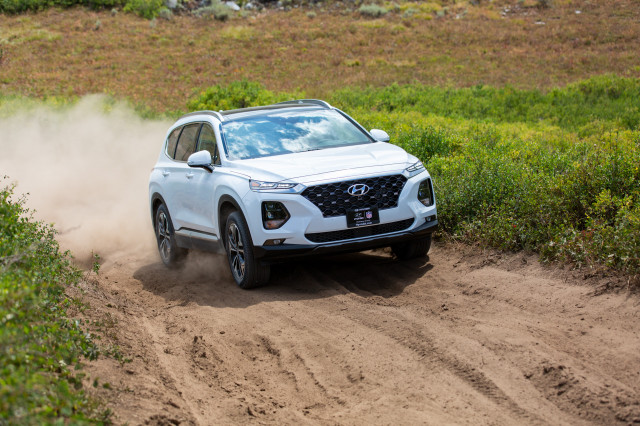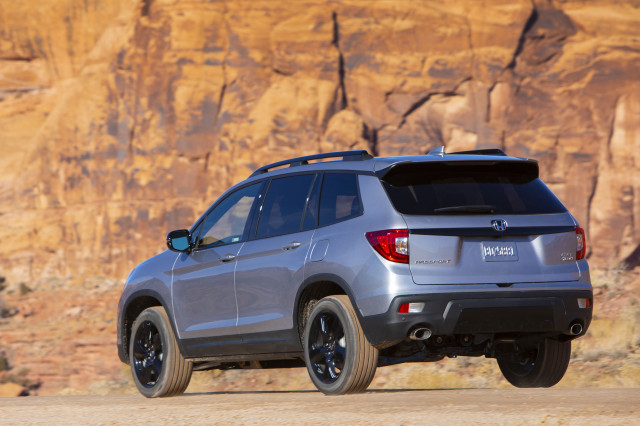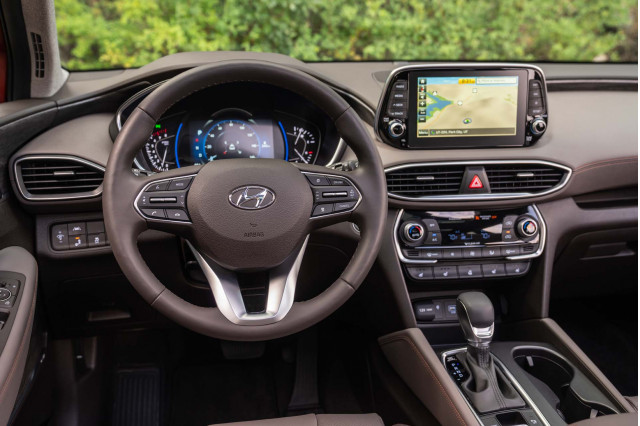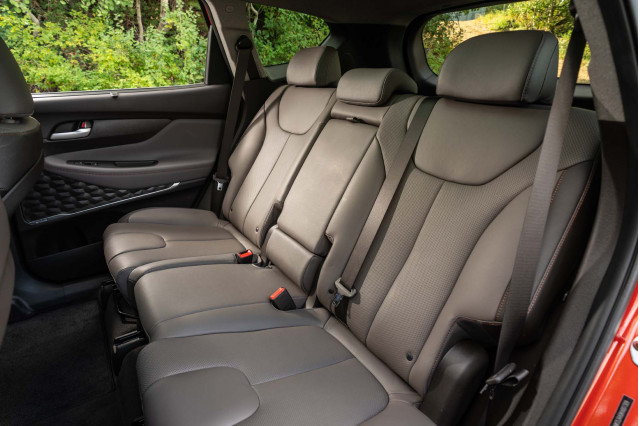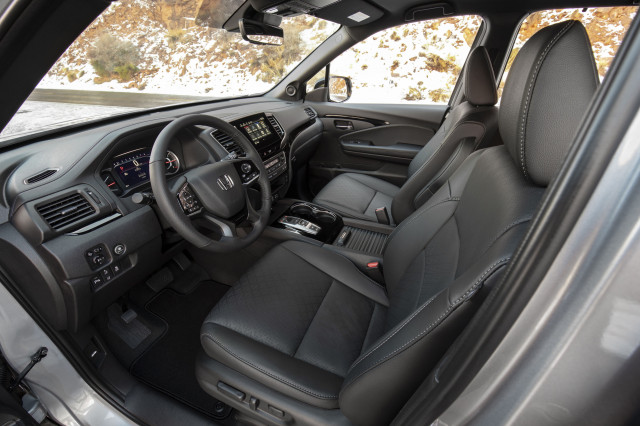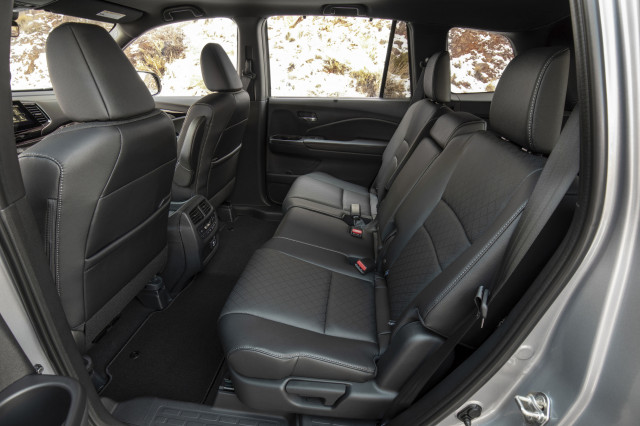2019 Hyundai Santa Fe first drive
More crossovers on the street mean that some can take a more direct road to consumers. The 2019 Hyundai Santa Fe now aims straighter for comfort, while the 2019 Honda Passport heads straight to the mountains.
We’ll call it addition by subtraction.
In the case of the Passport, never burdened with a third row thanks to the bigger Pilot, Honda’s newest crossover searches for dustier trails. Same goes with the Santa Fe, which gave up three-row life to the bigger Palisade in favor of a two-row mission instead. The “Santa Fe” name has appeared on all manner of crossovers for Hyundai before, but this year applies to just one vehicle.
The 2019 Santa Fe earned a 6.7 score on our overall scale thanks to its impressive comfort and quality. The 2019 Passport gets a 5.8, but there’s a caveat: we’re still waiting for official safety data, so that score may rise.
The numbers pronounce a winner, but there’s more to the story.
MORE: Read our 2019 Hyundai Santa Fe and 2019 Honda Passport full reviews
2019 Hyundai Santa Fe first drive
2019 Hyundai Santa Fe first drive
2019 Honda Passport
2019 Honda Passport
Style and performance
The Santa Fe wins on our style scale for two reasons. First, the new crossover ditched its old, curvier look for a more upright stance with bigger shoulders—its squarer jaw complements well the Santa Fe’s newfound machismo. The grille is wider, taller, and more imposing than before; it’s in contrast to Hyundai’s smaller SUVs that wear different noses now.
Second, the 2019 Santa Fe finds contemporary style in its materials and execution inside. We start by looking up: Limited and higher trim models get an optional tan headliner with a linen feel that’s exceptional. Everywhere else, the Santa Fe rises above the norm for the class in style and execution.
The Passport’s no slouch, but it’s not memorable either. The Passport is closely related to the Pilot (more on that in a minute) and looks nearly identical from the front. Around the side and back is where the Passport separates from the Pilot, but mostly because the Passport is roughly 6 inches shorter. Inside, the Passport is comfortable and quiet although it doesn’t strike out far on its own from the Pilot.
DON’T MISS: 2019 Hyundai Santa Fe first drive: Name a better deal
Under the hood is where the Honda comes into its own, where a 280-horsepower 3.5-liter V-6 is standard in all versions. It’s teamed to a 9-speed automatic that drives the front wheels, or all four wheels when equipped with AWD. The Honda engine is smooth and, despite a few hiccups from the transmission, we like it. We like the Passport’s ride, too; it’s calm and relaxed at highways speeds.
The 2019 Santa Fe relies on inline-4 power only, from one of two engines. The base engine is a 2.4-liter inline-4 that makes just 185 hp. Like the Passport, the base engine can power the front or all four wheels, but we’d hesitate to saddle it with any more weight—it’s overmatched.
The optional 2.0-liter turbo-4 is more willing, smoother with the Santa Fe’s 8-speed automatic, and better suited for all-wheel drive. It delivers 235 hp, which is more appropriate for highway passes.
Both crossovers are suited for dusty trails and bounding through adverse weather, but hardly equipped with serious off-roading hardware.
2019 Hyundai Santa Fe
2019 Hyundai Santa Fe
2019 Honda Passport
2019 Honda Passport
Comfort, safety, and features
Transporting people and gear is these two’s mission anyhow, and they mostly succeed.
The Passport offers the roomier rear seat between the two crossovers—it’s the stuff of dreams for long-legged adults. Up front, the Passport is spacious and comfortable, albeit a little drab.
The Santa Fe is spacious with more than 40 inches of rear seat room, but succeeds in its materials and fit and finish. Low-cost versions of the Santa Fe punch up, and tony trims feel even better.
In the end, it’s a tie that shoppers will have to break. The Passport boasts more stretch-out space and more than 40 cubic feet of cargo room; the Santa Fe has good, but slightly smaller, space for passengers and nearly 36 cubic feet of cargo room with a more polished interior.
The Passport hasn’t yet been crashed by any major safety rating agency but features standard automatic emergency braking, active lane control, and adaptive cruise control on every model. We expect it to do well.
MUST READ: 2019 Honda Passport first drive: Five seats, just right
The IIHS called the 2019 Santa Fe a Top Safety Pick+ (in top trims with optional headlights) and all models are equipped with automatic emergency braking, adaptive cruise control, active lane control, and blind-spot monitors.
For roughly $26,800 to start, the Santa Fe is the cheaper among the two, but it doesn’t stay that way for long. We see the best value at the Limited trim level, which costs about $33,500 for front-wheel drive and the base engine, or about $37,000 for all-wheel drive and the uprated turbo-4. For that much, the Santa Fe offers leather upholstery, a 7.0-inch touchscreen for infotainment with Apple CarPlay and Android Auto compatibility, heated front seats, dual-zone climate control, and premium audio. Hyundai’s standard warranty is 5 years/60,000 miles, bumper to bumper.
The Passport costs about $33,000 to start, and comparable equipment in the Passport EX-L to the Santa Fe Limited runs up the Honda’s price to nearly $40,000. The Honda’s warranty pales in comparison.
Our nod goes to the 2019 Hyundai Santa Fe for its good looks and value, but both crossovers carry up to five adults in comfort. That’s good news for buyers.
Summary
Styling
Performance
Comfort & Quality
Safety
Features
Fuel Economy
MSRP
Invoice
Fuel Economy – Combined City and Highway
Engine
Drivetrain
Source: Read Full Article


